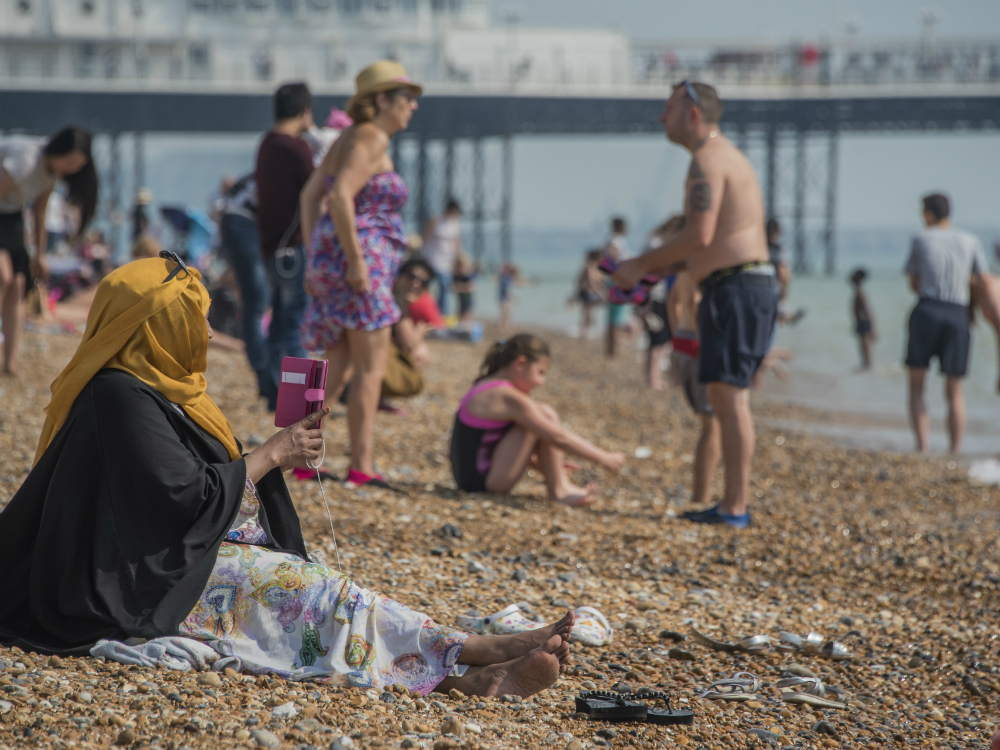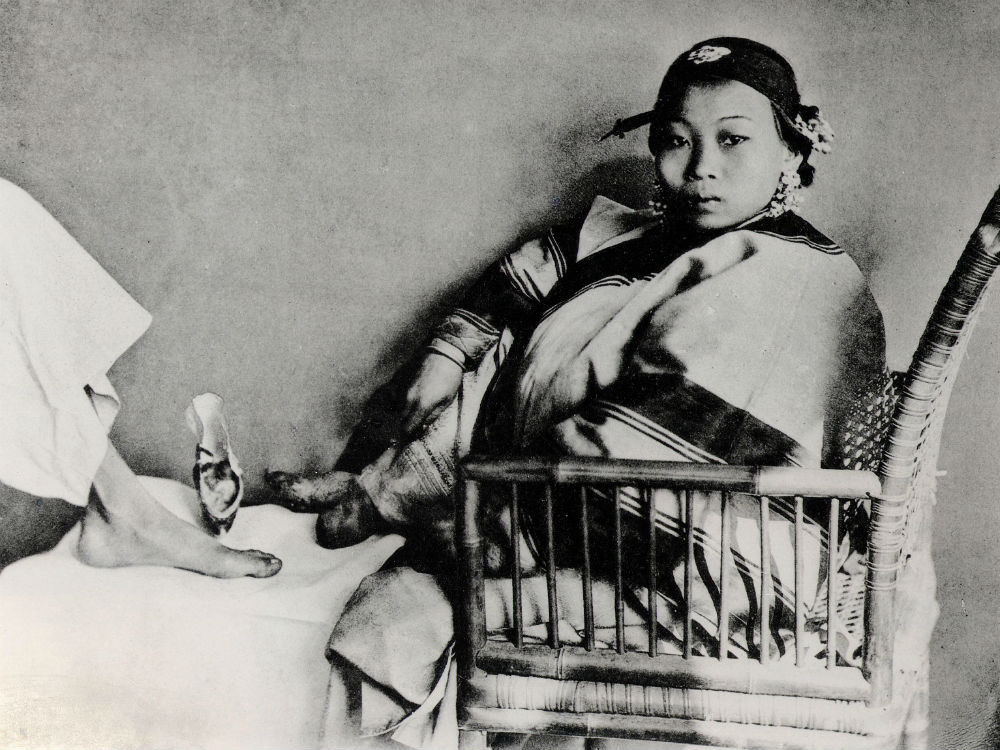A comprehensive timeline of men telling women what to wear
THIS HAS BEEN GOING ON FOR MILLENNIA.

THIS HAS BEEN GOING ON FOR MILLENNIA.
By Corinne Redfern
It doesn't matter if you want to leave the house wearing a clown costume, a £4k Dolce & Gabbana abaya or a pair of slightly-see-through-but-really-comfy leggings paired with a tie-dyed crop top - what you wear is always your choice.
Or at least, it should be.
And yet, throughout history, women have continually fallen subject to various rules and regulations that dictate what we 'can' and 'can't' put on our bodies. In fact, men telling women what to wear has been going on for thousands and thousands of years. So much so, that when we started making this timeline we thought it would take about 45 minutes. Instead, it took four and a half hours - and we'll probably have to come back and add to it some more next week.
From the recent burkini rulings in the south of France to the news that women in Iran are forced to cut off their hair and disguise themselves as men if they want to leave the house without a hijab - not to mention the ongoing insistence that rape victims should tell juries what they were wearing before their attackers are found innocent - society is still bafflingly obsessed with the way women cover up.
Not convinced? Read on and see the extent of the problem...
Celebrity news, beauty, fashion advice, and fascinating features, delivered straight to your inbox!

2016: BANNING THE BURKINI On the 28 July, 20 towns in the south of France decided to ban the 'burkini' and force Muslim women on beaches to remove their headscarves along the coast. Photos emerge of armed police surrounding one woman and forcing her to undress on the beach in front of hundreds of strangers, and protests take place all over the world in her defence. 2014: ISIS EXECUTES WOMEN NOT WEARING THE NIQAB WITH GLOVES Reports emerge from Iraq where ISIS claimed responsibility for stoning women to death because they weren't wearing gloves with their niqabs.
2009: WOMEN ARE ARRESTED FOR WEARING TROUSERS Thirteen women - including journalist Lubna al-Hussein - were arrested in Khartoum, Sudan, because they wore trousers in public. Ten of the women were punished with a fine of 250 Sudanese pounds, and received ten lashes. Lubna was fines $200, but not flogged.
1998: AN ITALIAN JUDGE LETS A RAPIST WALK FREE BECAUSE HIS VICTIM WORE TIGHT JEANS When a 45-year-old driving instructor was accused of raping an 18-year-old girl in 1992, he was convicted and sentenced. Then six years later, the Italian Supreme Court overturned the conviction - because his victim was wearing tight jeans. The defence argued that she must have helped the instructor remove her jeans - making the act consensual. The Italian Supreme Court said 'it is a fact of common experience that it is nearly impossible to slip off tight jeans even partly without the active collaboration of the person who is wearing them.' 1979: IRAN REIMPOSES THE HIJAB The Islamic Revolution in Iran overturned the liberal laws that had been enforced over the last 40 years, and women were suddenly forbidden from appearing in public without a headscarf. Counterintuitively, this ruling was actually celebrated by many women - simply because they could leave the house for the first time without the objection of their husbands and fathers.

1942: WW2 RATIONING BRINGS ABOUT RESTRICTIONS ON WOMEN'S CLOTHING While men's clothing remained the same, the USA introduced 'Regulation L85' which set skirt lengths at 17 inches above the floor - no longer, and no shorter. At the same time, material for swimwear was restricted - so swimming costumes become smaller as a result. Within two years, the bikini had made its debut - but came accompanied by a the rule that women shouldn't show their belly buttons. 1936: IRAN BANS THE HIJAB Iranian ruler Reza Shah made it illegal for all girls and women to wear the hijab in public, as part of a quick succession of liberal laws inspired by leaders in Afghanistan and Turkey. But the law was met with resistance from the religious majority, and many husbands and fathers began to forbid their daughters and wives from leaving the house so that they wouldn't have to remove their headscarves.
1919: LUISA CAPETILLO IS SENT TO JAIL FOR WEARING TROUSERS Writer and activist Luisa Capetillo from Puerto Rico argues publicly that women should have the same rights as men. After wearing a man's suit in public, she was sent to jail - although the judge eventually dropped the charges against her and set her free.
1890s: ANKLES ARE OUT. AND, ER, SO ARE TABLE LEGS... It was decided in the UK that women must cover their whole bodies in public - necklines were raised to just below the chin, and hemlines dropped to below the ankle. Diagrams were released to clarify what length of skirt was suitable for what age (four year old girls could wear dresses to just below the knee - but girls of 16 must wear dresses to the arch of their foot. Legs of wooden tables were covered up too, because they apparently resembled women's legs. Which is insulting to say the least.
1800s: WOMEN GET POCKETS FOR THE FIRST TIME For the first time in British history, women's dress patterns were allowed to include pockets. Until now, if women had access to money (which was significantly less often than men), they'd had to cut slits into the sides of their skirts. Sure, they could reach through to access two hanging drawstring pouches which they suspended on a belt underneath their dress, but it was considered vulgar for a woman to hide her hands (unless they were wearing gloves). Men, meanwhile, had pockets since the 1600s. And they worked just fine, by the way.
1600s: RICH WOMEN ARE MADE TO WEAR HIJABS Historians argue that during the Ottoman Empire and across the Middle East, male scholars began producing huge volumes of Islamic scripture and legal works to regain the patriarchal power that they'd lost in the centuries following Muhammad's death. As a result, the hijab was deemed representative of female modesty and piety - while also symbolising the upper class. Poorer women, who worked as labourers, were able to avoid wearing it because of its impracticality while farming - meaning that 'a veiled woman silently announced that her husband was rich enough to keep her idle.'
1550s: 'THICK WAISTS' ARE BANNED FROM COURTS IN FRANCE Those attending courts in France were forced to wear corsets made out of wood or whalebone - with guards checking upon entry. Laced tightly together, women worked to attain the smallest waist possible - often aiming for 14 or 16 inches. The trend soon spread overseas, and most women continued wearing them up until the 19th century.
1056: WOMEN IN GERMANY AREN'T ALLOWED TO WEAR SILVER, GOLD, OR PRECIOUS STONES Unless they're married to a knight. Obviously.

900AD: CHINESE WOMEN START BINDING THEIR FEET In one of the cruelest fashions for women throughout history, women in China began being made to bind their feet during the sixth century. Seen as a symbol of beauty, legend has it that the Emperor at the time saw the dainty feet of one of his favourite courtesans, and enforced a ruling that all women in his court must make their feet tiny and curved too. The practise continued until 1949.
627AD: THE HIJAB IS IMPOSED FOR MUHAMMAD'S WIVES Originally, the word 'hijab' could mean 'veiling' or 'seclusion' - but it only became enforced when Muhammad began entertaining increasing numbers of male visitors in the mosque where he lived. The visitors would often sleep metres away from Muhammad's wives' quarters - so a 'hijab' was imposed to keep the women separate and 'safe' from the men. For a long time, historians believe that the phrase darabat al-hijab (donning the veil) was synonymous with 'being Muhammad's wife'. Wearing the hijab only entered the public sphere centuries after Muhammad's death.
44BC: LAWS ENFORCE WOMEN'S CLOTHING As the Roman Republic transitioned into the Roman Empire, the whole toga-versus-stola thing became official, as a law was passed that officially forbade women from wearing the toga under any circumstances. At the same time, women's rights were decreased. Again, just a coincidence.
200BC: MARRIED WOMEN ARE MADE TO DRESS DIFFERENTLY In Ancient Rome, women were made to start wearing a floor-length, modest gown called the 'stola' as soon as they were married. Up until this period, women had been allowed to wear the toga, just like men, but after 200BC it was considered 'disgraceful' for a woman to dress the same way as a man - and was often associated with prostitution or infidelity. Oh, and if you're into facts - the Statue of Liberty wears a stola too.
400-500BC: MODESTY IS IMPOSED - KIND OF Nobody is completely certain why breasts suddenly started being covered up in Ancient Greece, but sculptures from that time show goddesses hiding their chests behind their hands, or dressing in over-sized, flowing robes that hung loosely over their upper bodies. Amazingly considering today's approach to the female body, many paintings from this era still show women's genitalia and upper thighs - although this eased off towards the turn of the millennium. Interestingly, as women became increasingly covered up, so Greece became an increasingly patriarchal society - as women were made to stay at home under the control of their fathers and husband. But clearly that's just a huge coincidence.

1500BC: BREASTS ARE EVERYWHERE Historians reckon that women only began to cover their breasts in public about 3500 years ago - when men decided they were private, sexual body parts that needed to be tucked away. Prior to that, artwork from the era suggests that women were able to wander around topless without anyone batting an eyelid. Even during the days of Ancient Egypt, historians believe that women could choose whether to cover their breasts or not - often opting for elaborate dresses and designs that would leave one breast exposed.
2500BC: VEILS FOR THE RICH - BUT NOBODY ELSE Used as a means of identifying which women are 'respectable' and which women are 'publicly available' to men, upper class women in ancient Mesopotamia are made to wear veils that are wrapped loosely over their hair and fall to their waists, but poorer women are not allowed to - and face harsh punishments if they dare to.
The leading destination for fashion, beauty, shopping and finger-on-the-pulse views on the latest issues. Marie Claire's travel content helps you delight in discovering new destinations around the globe, offering a unique – and sometimes unchartered – travel experience. From new hotel openings to the destinations tipped to take over our travel calendars, this iconic name has it covered.